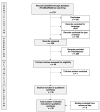A Systematic Review of Atypical Endometriosis-Associated Biomarkers
- PMID: 35457244
- PMCID: PMC9029517
- DOI: 10.3390/ijms23084425
A Systematic Review of Atypical Endometriosis-Associated Biomarkers
Abstract
Ovarian endometriosis may increase the risk of malignancy. Several studies have suggested atypical endometriosis as the direct precursor of endometriosis-associated ovarian cancer. We performed an advanced, systematic search of the online medical databases PubMed and Medline. The search revealed n = 40 studies eligible for inclusion in this systematic review. Of these, n = 39 were finally included. The results from included studies are characterized by high heterogeneity, but some consistency has been found for altered expression in phosphoinositide 3-kinase (PI3K)/AKT/mTOR pathway, ARID1a, estrogen and progesterone receptors, transcriptional, nuclear, and growth factors in atypical endometriosis. Although many targets have been proposed as biomarkers for the presence of atypical endometriosis, none of them has such strong evidence to justify their systematic use in clinical practice, and they all need expensive molecular analyses. Further well-designed studies are needed to validate the evidence on available biomarkers and to investigate novel serum markers for atypical endometriosis.
Keywords: atypia; atypical; atypical endometriosis; biomarker; endometriosis; marker.
Conflict of interest statement
The authors declare no conflict of interest.
Figures
References
-
- Sampson J.A. Endometrial carcinoma of the ovary, arising in endometrial tissue in that organ. Arch. Surg. 1925;10:1–72. doi: 10.1001/archsurg.1925.01120100007001. - DOI
-
- Scott R.B. Malignant changes in endometriosis. Obstet. Gynecol. 1953;2:283–289. - PubMed
-
- Pearce C.L., Templeman C., Rossing M.A., Lee A., Near A.M., Webb P.M., Nagle C.M., A Doherty J., Cushing-Haugen K.L., Wicklund K.G., et al. Association between endometriosis and risk of histological subtypes of ovarian cancer: A pooled analysis of case–control studies. Lancet Oncol. 2012;13:385–394. doi: 10.1016/S1470-2045(11)70404-1. - DOI - PMC - PubMed
Publication types
MeSH terms
Substances
LinkOut - more resources
Full Text Sources
Medical
Miscellaneous


